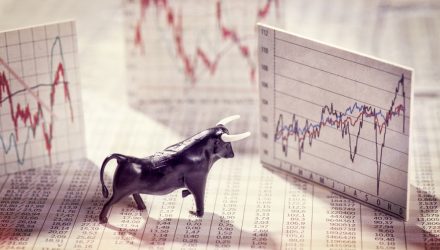Some fixed income investors may feel as though the bond market is currently treacherous territory. Those feelings are not unwarranted; however, there are some bright spots. Investment-grade corporate credit could be one of those sources of allure.
Recent economic data — namely last week’s impressive initial third-quarter GDP report — seems to support the thesis that high-quality corporate bonds could prove resilient in the months ahead. That could encourage fixed income investors to consider exchange traded funds such as the Calvert Ultra-Short Investment Grade ETF (CVSB).
Recent sturdiness among investment-grade corporate bonds and ETFs such as CVSB is critical because professional investors often believe credit leads equity, meaning corporate bonds can act as harbingers of things to come in the stock market.
“Credit has a reputation of being the scouts of financial markets, sniffing out and detecting danger well ahead of others,” noted Andrew Sheets, head of corporate credit research at Morgan Stanley. “In 2000, 2007 and 2011, to name a few, credit markets started to weaken well before other asset classes in flagging danger. The Federal Reserve used credit spreads as one of their most important measures of financial stress.”
Why Investment Grade ETF CVSB Matters Today
Just as credit can be a tell on what’s next for stocks, it can function in similar fashion when it comes to forecasting economic strength or weakness. That’s a tough job. Just ask an economist. However, the aforementioned GDP report, coupled with sturdiness in ETFs such as CVSB, could be positive signs.
“First, credit is very sensitive to the likelihood of a deep recession. Recent data has been good, with the U.S. economy growing a whopping 4.9% in the third quarter. While our US economists expect slower growth in the fourth quarter, we think a generally stronger than expected U.S. economic story has, and should continue to be, helpful to corporate credit,” added Sheets.
CVSB is also potentially attractive to astute bond investors because the Calvert fund is actively managed. That implies the ETF can be more responsive in mitigating interest rate risk — an important consideration with 10-year Treasury yields elevated. Active management also can be impactful when it comes to capitalizing on emerging credit opportunities.
“Credit has a well-deserved history as an early warning signal for markets,” concluded Sheets. “But for now, we think it is better to view it as a financial markets passenger. Government bond yields and earnings are in the driver’s seat and are much more likely to be important for driving overall direction. For now, we think this can suit credit just fine and continue to expect it to be a relative outperformer.”
For more news, information, and analysis, visit the Responsible Investing Channel.

